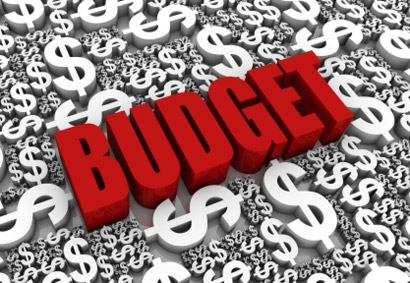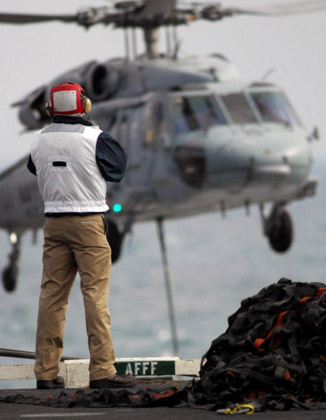Rear Admiral Phil Cullom: A Warrior’s Energy Ethos
I“have always tried to look at things through the lens of a quarter of a century because when a person subscribes to the ‘art of the long view,’ he or she ends up making better strategic decisions. If you can see what the inextricable trends are, realizing there will always be instabilities and unpredictable events, and plan for them, you’ll come out ahead. Being a father supports this view because having kids makes you think about where things are going to be one, two or three decades out. Parents want their children to have a better world than they did, which is why it’s important to make a positive contribution while we’re on this little blue sphere. Energy transformation is an important part of this equation because, after all, what kind of world are we going to leave future generations?” asks Rear Admiral Philip H. Cullom, Director of the U.S. Navy’s Energy and Environmental Readiness Division and its Task Force Energy.
Task Force Energy (TFE) has taken a leadership role in requiring, supporting and producing energy efficiencies not just for the benefit of the Navy, but for all energy consumers. Cullom explains that the Navy “may only have 500,000 people, but they represent America. Our Sailors and civilians come from all walks of life. If they all learned to value energy, that’s a miniscule population with regard to changing America-at-large. But, it’s an important one because the military is known for, once given a mission, accomplishing its mission. They don’t just talk about it. The military shows results and those results begin to prove to everyone else that there’s something to this. Simultaneously, we also have to show the goodness such change will bring. We’re confident that at the end of the day, the results will speak for themselves.”
One of TFE’s missions is to plan for results that can be replicated in a much larger fashion. As the Navy shows energy efficiencies for military reasons, i.e., to buy combat capability, it will become clear what this process will buy for consumers and America. Cullom says energy efficiencies “will buy back part of a family’s income, which means quality of life and living standard will improve. If our energy transformation shows we can become more self-sufficient as a Navy, then we can become more self-sufficient as a nation. This means more of our capital will get replowed back into our own economy.”
Addressing Culture Change
According to the TFE Director, leadership at the top is vital to effective energy change due to institutional inertia. Because energy has been inexpensive for a long time, there has been no incentive to change. In the past energy was a “pass-through.”

© iStockphoto.com/VCTStyle
Cullom provides an example of this by commenting: “In 2007, the Navy’s fuel bill was $1.2 billion. When energy costs escalated to $147/barrel in 2008, the year I took on the energy task, the Navy’s annual fuel cost would have been $5.1 billion had prices stayed at that level. That type increase is not okay anymore because everyone is operating under the knowledge that contingency operation money isn’t going to be with us forever. In fact, if bills go from $1.2 to $5.1 billion, expect to get $4 billion less of something else. Sooner or later it starts cutting into future capabilities – America’s future force. Or, it can cut into present operations by physically impacting how America operates its force.”
With these consequences in mind, the Navy’s TFE is addressing three primary challenges this year. First and foremost is culture change. According to Cullom, this means “getting everyone in the Navy to make energy transformation part of everything they do. But this is easier said than done, as every service can attest to as they encounter similar difficulties. You can say it, and it can be on your bumper sticker. But then you must implement it so every Airman, Sailor, Marine and Soldier is really living it day to day as part of who they are. That’s the challenge for us: to craft as clear a message as possible so that our Sailors are properly incentivized to go down that path. And, we need to measure performance so they can be recognized for their contribution. We have a few ideas on how we’re going to accomplish this, but change is hard, particularly in an era of fiscal restraint.
“We have to show that there’s a return for the nation, a return for the Navy in whatever we do in the energy lane. It also has to have some sort of bottom line to it. We’re putting metrics in place, but we’re cognizant of the adage ‘be careful what you ask for.’ We can choose a metric, but if we choose poorly then that metric will drive bad behaviors. That’s certainly happened at one point or another to probably every department in the Federal government. We have to pick wisely and doing that requires thinking through positives and negatives associated with pursuing different metrics so they get us to a better place. The Secretary of the Navy (SECNAV) has isolated five metrics with associated timelines, but our challenge is to convert those into something that matters to the average Sailor,” explains Cullom.
Addressing Ungoverned Space
The second challenge for TFE is C5I (Command, Control, Communications, Computers, Collaboration and Intelligence) energy. America uses massive amounts of energy today just to push information from place to place, and the military is no exception. According to Cullom: “We’re using more and more energy just to make our information systems work – whether it be radars bringing in information, sonars ensonifying water to indentify information or transmitters sending information to a satellite. These things have an energy cost we rarely think about.
“Ten years ago, if you went to any military communications facility on any base, there would be one to two antennas. Today, you’ll find a multitude; some are big dish antennas; some are whip antennas; others are dipole antennas. Up to this point, we haven’t known how much energy this is costing because the base had one meter at its entrance measuring all energy usage. Nobody knew if that energy was heating a hangar, providing power for the truck fueling station, the communications center or a headquarters building. One of our challenges is that we now need to know where that energy is being used.
“If I had to figure out a term for the C5I energy environment, it would probably be the ‘ungoverned space’ because people consider it the cost of doing business. They also consider more is better although no one in the past has planned for, or thought about, what it’s going to cost. That’s been one of the biggest contributors to why every new platform has required more and more energy – because every time we turn around we add more communications devices. As an example, one of my first ships was a baseline frigate. I could count on two hands the number of ways we could communicate by radio. Today, almost every ship has more communication devices than I have fingers and toes. That’s because we’ve found more is better, so we keep packing on more and more. The question comes down to, ‘Do we actually need all that information, and is there a way to push that information more efficiently around the virtual battlespace?’”
Addressing Energy Efficient Acquisition
 The third big TFE challenge, one of SECNAV’s challenges, is energy efficient acquisition. Cullom maintains that the Navy has to “fundamentally figure out how to build things that don’t just keep using more and more energy. I would suggest that because of the linear way we’ve gone about things in the past – the paradigm, the process or whatever, and because energy was cheap – we didn’t worry about using more energy. Like Lucille Ball and the chocolate factory, more chocolates, in terms of needed energy, just keep coming out of the conveyor belt of new systems. This is another area where we need to figure out what the right metric or metrics are for defense contractors to meet.
The third big TFE challenge, one of SECNAV’s challenges, is energy efficient acquisition. Cullom maintains that the Navy has to “fundamentally figure out how to build things that don’t just keep using more and more energy. I would suggest that because of the linear way we’ve gone about things in the past – the paradigm, the process or whatever, and because energy was cheap – we didn’t worry about using more energy. Like Lucille Ball and the chocolate factory, more chocolates, in terms of needed energy, just keep coming out of the conveyor belt of new systems. This is another area where we need to figure out what the right metric or metrics are for defense contractors to meet.
“Formally in the past, we’ve always waited until gate review three, four, five or even six before we said, ‘Hey, is this energy efficient?’ With respect to acquisition, procurement and review, where do we put energy? Is it part of the joint capabilities integration system? Is it part of the defense acquisition system? Is it a logistics issue; is it a sustainment issue; is it a technical issue? The correct answer is that it’s all of the above. It also has to be in the PPBE (planning, programming, budget and execution) process. We need to put energy into the beginning when we define the requirement. This is where we’re working to make a difference so that new starts will have a requirement to be energy efficient. The first time industry sees this showing up, they’ll be believers. We’re in the process of making this happen today. The bottom line is that if you’re building something for the Navy, you’ll be required in the very beginning to show its energy efficiency.”
Addressing a Warrior Energy Ethos
Where is the U.S. Navy going with all this? Obviously, they’re changing their culture by becoming energy smart. But, do they have a warrior ethos about it? Is energy part of their new ‘weapons systems?’ According to Cullom, if it isn’t now, it soon will be.
“Energy for the Navy,” explains the TFE Director, “is like a Spartan’s weaponry. Is it our shield; is it our spear; is it our sword; is it our helmet? This type thinking helps translate SECNAV’s goals for people like me, who have been wearing the uniform. There’s a link between an energy smart navy and an energy smart nation. The concept and operations component have to make sense for us. How do we translate it? We have a mission to do, and our mission consists of all the things the Cooperative Strategy for a 21st Century demands of us. Sometimes it’s humanitarian assistance; sometimes it’s disaster relief. Sometimes it turns out to be the forceful power that’s able to dissuade adversaries from doing something or, when need be, to conduct combat operations, i.e. to be able to right a wrong.

U.S. Navy photo by Mass Communication Specialist 3rd Class Ricardo J. Reyes
“Our energy culture change has to be in keeping with the Navy’s culture and our military culture as warriors. Doing that means improving and becoming more efficient with the existing fleet. And, retooling the existing fleet is about becoming more energy efficient. Energy efficiency makes us more combat capable, more Spartan, more self-sufficient, more able to do our missions without a long logistics tether behind us. We’ve got to be able to make things more energy efficient from the beginning. It’s not just about defining a new requirement; we have to change the process.
“Task Force Energy must feed two masters: increase combat capability while simultaneously reducing energy use. By 2020 the Navy must save five million barrels of fuel while supplanting eight million barrels with biofuels to achieve SECNAV’s goal that 50 percent of our tactical energy be from sources other than petroleum. Although the cost of biofuels is pretty expensive right now, these costs are dropping rapidly. According to our MIT study, the cost parity point for algae as a biofuel will occur sometime between 2018 and 2022. With the right incentives, as we are seeing emerge today, this could be even earlier.”
Addressing New Opportunities
In addition to culture change, addressing C5I ungoverned space and implementing energy efficient acquisition, TFE is also promoting formal energy education. Not only will the Navy offer two Masters degrees at their Naval Postgraduate School, but sustainability and energy education will be incorporated into every school their officers go to upon commissioning.
Another Navy success story is its Energy Forum, which began in 2009 as a combined Navy/Marine Corps Department of the Navy Energy Forum and has continued annually as TFE’s Navy Energy Forum. Cullom comments that he’s “looking at the Navy Energy Forum as a bright light to help advance energy discussions and solution sets. Every October we bring together what we hope is the right combination of people associated with Navy operational efforts, industry and academia so everyone doing something on energy can get together and help the Navy better craft its energy future. Every year provides an opportunity for us to bolt to the next level because of the new technologies and ideas coming out all the time.
“While we look at the things we know can have immediate return because the technology is very mature, we continually need to be pushing our own ability to innovate and to be very creative in new solutions that become generational leaps in technology. That’s what America is really good at. We’re never satisfied with the horizon; we’re never satisfied with where the frontier is. When you subscribe to the ‘art of the long view’ and find those inextricable trends, you have to be relentless about pursuing them, even when things don’t necessarily look like they’ll work out. It has to be a process, a journey. And, you have to keep on believing because if the only reason you’re on the planet is for yourself, then that’s a pretty shallow life.”




























